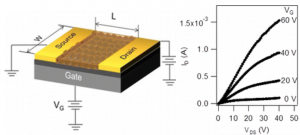Congratulations to Christian and Kevin for publishing their paper “Chalcogenidometallate Clusters as Surface Ligands for PbSe Nanocrystal Field-Effect Transistors” in J. Phys. Chem. C.
In this manuscript we report on a post-assembly ligand exchange strategy for converting films of PbSe nanocrystals into inorganic nanocomposites capped with chalcogenidometallate clusters (ChaMs), and implement them in field-effect transistor channels. Previously, inorganic nanocrystal composites capped with ChaMs were prepared by replacing the nanocrystals’ organic surfactants with the inorganic clusters via a biphasic solution exchange, and then annealing films of this material at high temperatures to form an all-inorganic composite. This method works reliably for semiconductor nanocrystals like cadmium selenide, but lead chalcogenide nanocrystals do not survive solution exchange due to their unstable surface chemistry. In this manuscript we develop a post-assembly exchange process for replacing organic surfactants with ChaMs without damaging the PbSe nanocrystals, and thereby expand the variety of surface ligand chemistries that couple with PbSe nanocrystals for optoelectronic device applications. Nanocrystal field effect transistors fabricated from our methods show mobilities as high as 1.3 cm2/V-s. To our knowledge, this is the first solid exchange procedure to produce ChaM-functionalized PbSe nanocrystal FETs with high carrier mobility (>1 cm2/V-s) without the aid of device modifications such as in-filling with high capacitance oxides or surface doping with lead atoms. This mobility is comparable to the highest recorded figures for hydrazine-only treated devices and is an order of magnitude higher than the best ammonium thiocyanate-functionalized films. Our solid exchange process could serve as a template for facilitating ligand exchange on a wide variety of colloidal nanocrystals regardless of their surface stability/chemistry.


